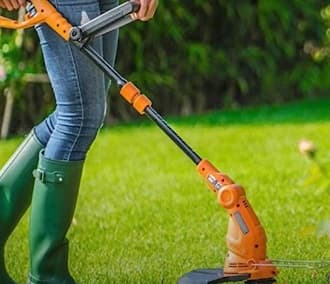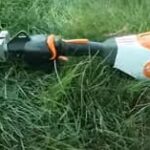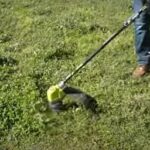As an Amazon Associate, this site earns commissions from qualifying purchases. For more information click here.
Is your string trimmer no longer working and just completely halted? There is probably something wrong with its clutch. This is an integral part of the tool and knowing how it works is a must if you own a trimmer or weed eater. This article also looks at the reasons why the clutch goes bad and how to fix or replace it.
The most common sign of a broken string trimmer clutch is a non-responsive throttle. When you press the throttle the trimmer head should spin, and it should stop when you disengage. If the clutch is damaged the trimmer head will move erratically or not at all.
How a String Trimmer Clutch Works
At the heart of gas-operated string trimmers is the centrifugal clutch. Designs may vary, but it is used to control the trimmer line. The clutch relies on centrifugal force so when you throttle the trimmer, the engine and clutch engage.
When you engage the clutch, the string trimmer spins and trims grass. If you disengage the clutch it will stop cutting, but the engine remains idle.
A lot of power tools use centrifugal clutches because it is low cost and effective. However it can suffer damage and prevent the string trimmer from working.
Now that you understand what a centrifugal clutch is and what it does, we can take a look at the signs and symptoms of damage.
Signs of a Bad String Trimmer Clutch
A string trimmer clutch can go bad for many reasons, but these are the most common. If you encounter clutch problems, chances are high that these are the culprits.
The trimmer does not work. This is as simple as it gets. When you turn the trimmer on it will not run. If you have ruled out other possibilities like lack of gas, wrong fuel and other engine problems, you are looking at a broken or worn-out clutch. Probably both, as the clutch often suffers damage due to wear and tear.
This is why buying a quality weed eater is so important, as these problems are minimized. If you are searching for one, we recommend the Husqvarna 128LD because it is durable and versatile.
The trimmer no longer responds. Another sign of a faulty clutch is a non-responsive trimmer. If the clutch is working, the trimmer should spin when you engage the throttle and stop when you release it.
But if the clutch is damaged, the throttle response will be slow or none at all. Of course you have to rule out other possible reasons, but in these cases it is usually due to a broken clutch.
Now that you know the symptoms of a damaged trimmer clutch, it is time to look at the causes and why this happens.
Causes of String Trimmer Clutch Damage
Regular maintenance is the best way to keep a trimmer clutch working. Using the tool only for what it is designed for is another.
But knowing the reasons why the clutch is not working is a must. In many cases the clutch is already damaged and has to be replaced. But problems with other engine parts can make a clutch stop working, so knowing the causes makes a difference.
Wear and Tear
In many cases the clutch is simply worn out. Well-made string trimmers have durable clutches, but eventually it is going to break down.
Proper use and maintenance is going to prolong its life but a replacement will be needed at some point. Constant use of the trimmer also causes the boots and housing to smooth and affect the clutch.
Wear and tear is also one of the reasons why a trimmer auto feed may stop working, though there are other possibilities. You can check out this article on how to fix string trimmer auto feed for more details.
Metal Fatigue
String trimmers can run in high and low temperatures, but metal fatigue can arise from overheating. When the clutch is engaged, it produces friction which in turn generates heat.
Repeated friction and heat leads to metal fatigue, which can fracture the spring-loaded boots. The metal in these boots can also suffer from fatigue. When this occurs the spring won’t have enough power to draw the clutch back.

Wrong Installation
If you replaced the clutch and installed it incorrectly, the trimmer will not run. In some cases you might get the engine to start but the clutch performs erratically.
It is easy to find a replacement clutch for your trimmer. The manufacturer site is the best place to start. But make sure the clutch is installed properly. Depending on the trimmer design the process will differ from one trimmer to another. If you are using the Craftsman 41ADCS25793 trimmer for instance, the clutch has to be compatible with it.
Defective Spark Plugs
A heavily used gas string trimmer can wear out its spark plugs quickly. These can also burn out or get clogged with carbon deposits after a while.
Any time you have a problem with a 2-stroke engine, the spark plug is a good place to start checking. Refer to your owner’s manual to locate it.
Examine the spark plug. Get a replacement if it looks burned out or the ends have worn out. If the spark plug doesn’t look damaged but is covered with dirt, clean it. Try the spark plug to see if it works.
If the spark plug is old, replace it. Old plugs are hard to clean as the dirt is often stuck and it is easier to buy a replacement. But if the spark plug is new and refuses to work, use a spark plug tester to check if it is functioning.
Worn Out Spring
The clutch is made up of spring loaded boots and the housing. The spring keeps the boots together as the engine idles. But when the throttle is engaged and the engine runs fast, the boots split up The split boots touch the housing and make it spin, along with the trimmer head.
If the clutch spring is damaged or worn out, the trimmer head will begin spinning the moment the engine is turned on, whether it is idle or not.
If you engage the throttle, the trimmer head starts moving in an unpredictable manner. It might spin too fast or not at all. You are going to hear loud noises in the trimmer and the erratic spins can damage the trimmer or cause personal injury.
The only solution is to replace the spring. You might have to replace the whole trimmer head depending on how worn out the components are. But if they are still usable, cleaning will be more than enough.
Debris in the Clutch
The centrifugal clutch assembly can get clogged by weeds, dust and debris. A bit of dirt is not going to impede operation, but too much and it becomes a problem. Fortunately, cleaning the assembly is straightforward.
Shut the string trimmer down and let the engine cool off. Take off the bolts locking the shaft to the engine. This should give you access to the clutch assembly cover. Remove the cover screws.
Wipe dirt off the assembly. Look for signs of damage or wear on the springs and metal fractures. If the springs are still working and there are no metal fractures, you can put the cover back on after cleaning.
If the springs are worn out you can buy replacement parts easily. But if there are metal fractures, you might have to replace the entire assembly.
How to Replace a String Trimmer Clutch
Empty the fuel tank. Use screwdrivers to remove the screws locking the shaft to the motor. You might have to disconnect some wires and cables on the carburetor.
Once the motor is separated from the shaft, take out the clutch drum screw that locks the clutch on the motor.
To remove the piston cylinder, take out the spark plug. Now you can take out the clutch drum screw and the plates.
The exact process may vary depending on the string trimmer. In general though the steps are straightforward. You just have to remove some screws and bolts. Once you have taken out the assembly, you can install the new one.
You only need to replace the clutch assembly if there are metal fractures. If there are only minor issues with the spring or cleaning required, you can replace the other components without removing everything.

I love the outdoors and all the tools for maintaining gardens, yards and lawns. The only thing I am more passionate about is sharing what I know about garden and outdoor equipment.


